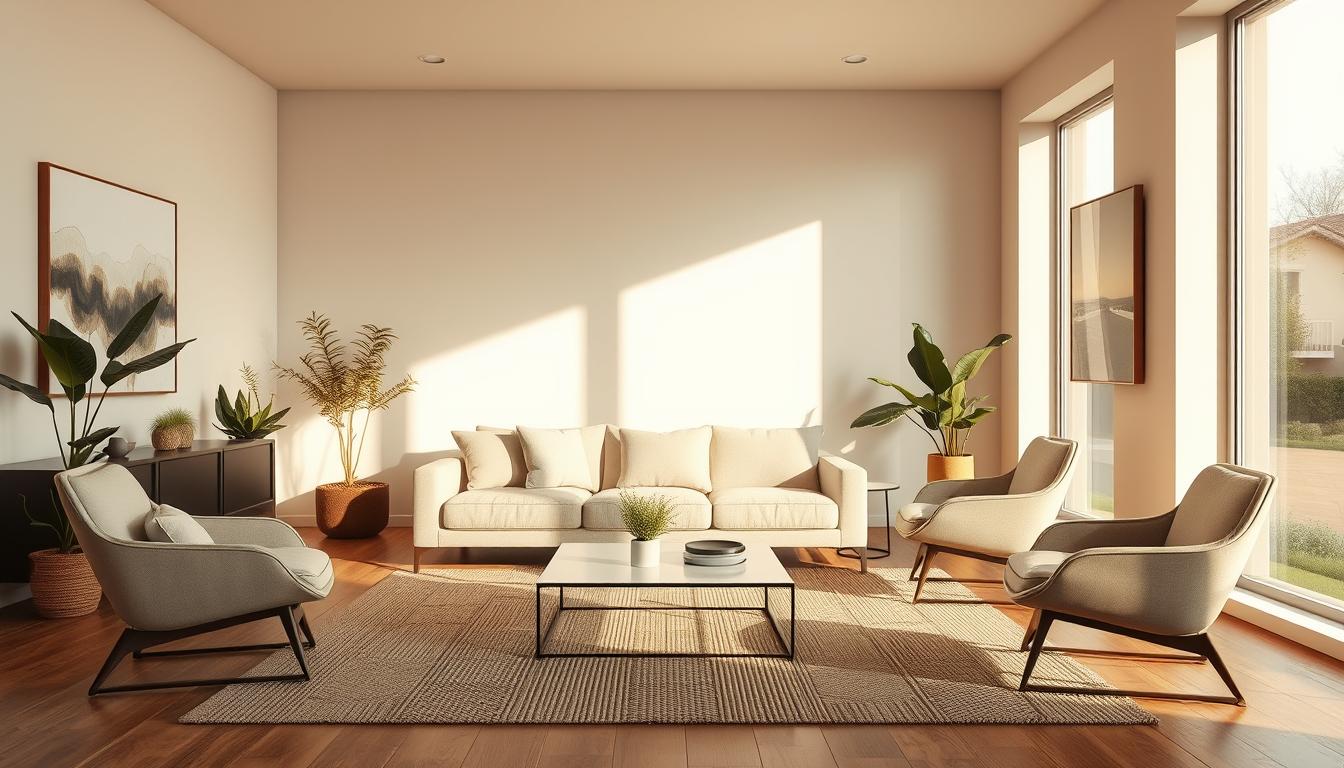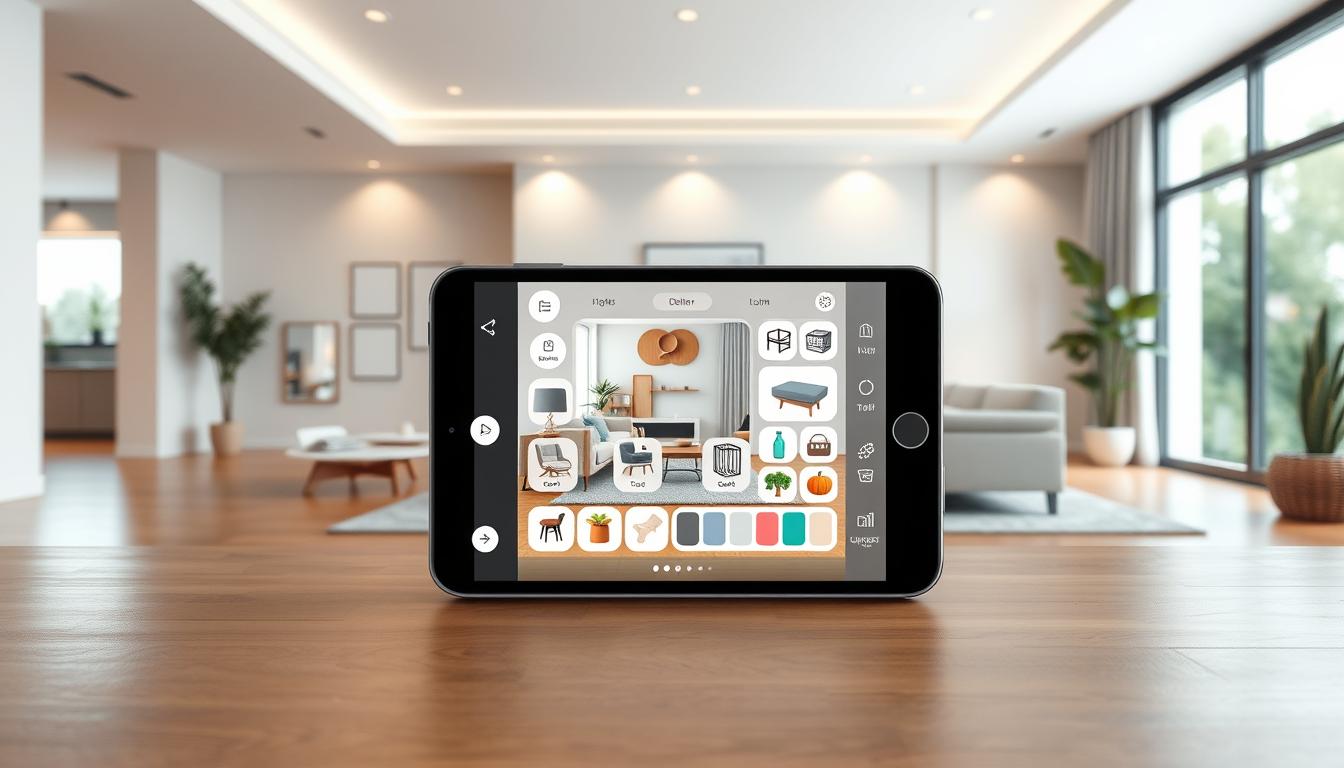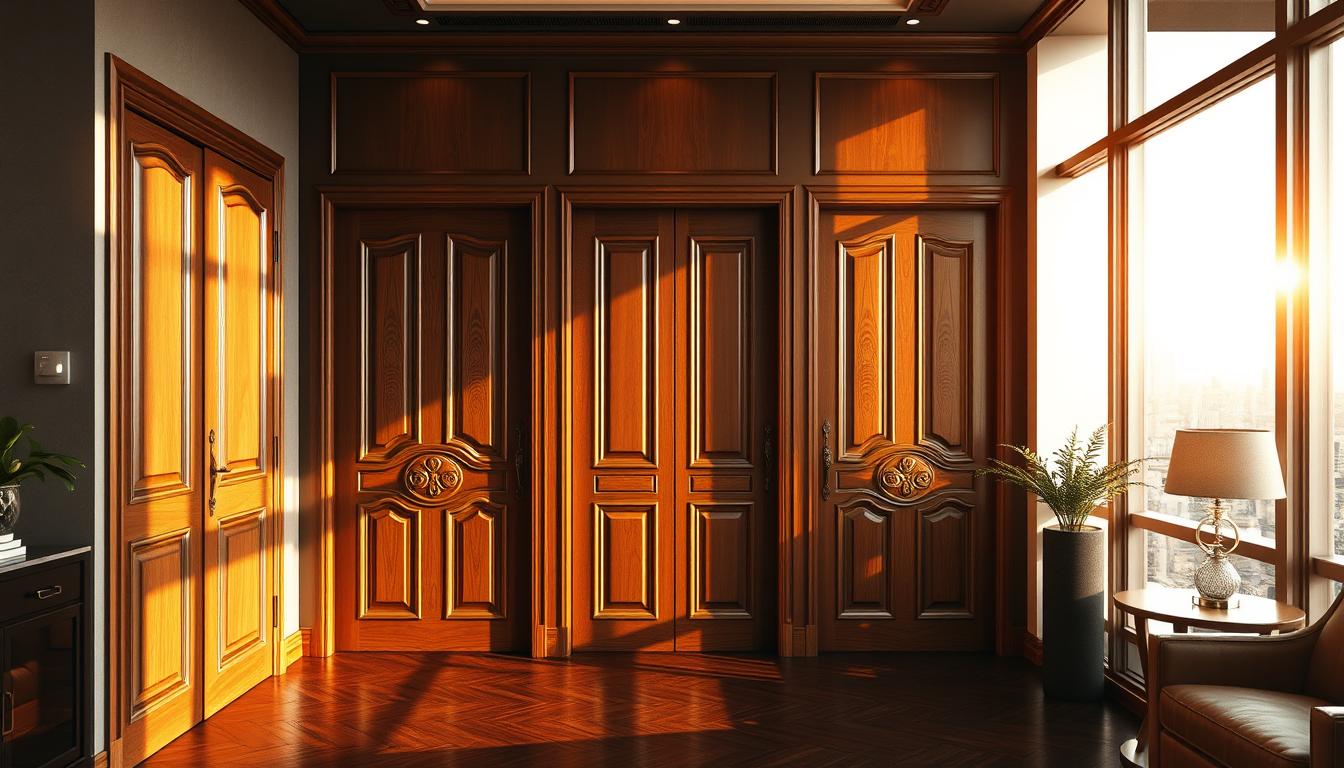Did you know that how we design our homes can really affect our mood and how productive we are? With so many interior home styles out there, picking the right one can be both fun and a bit confusing.
As we dive into the world of modern home decor ideas, you’ll find lots of design choices. These can help turn your house into a home that shows off your personality and style.
We’ll show you through the many interior design trends. This will help you make a beautiful and useful living space.
Key Takeaways
- Understanding different interior home styles to suit your taste.
- Exploring modern home decor ideas for a contemporary look.
- Learning how to balance functionality with aesthetics.
- Discovering how to personalize your space.
- Tips for selecting the right design elements for your home.
Understanding Interior Home Styles
There are many interior design trends out there. It’s important to know the basics of different home styles. These styles show who we are, how we live, and what we like.
What Are Interior Home Styles?
Interior home styles are the unique looks and designs of a home’s interior. They come from history, culture, and personal taste. Popular styles include traditional, modern, contemporary, and more.
Each style has its own look, like colors and furniture. Modern homes have simple lines and focus on function. Traditional homes have classic furniture and rich colors.
Importance of Choosing the Right Style
Choosing the right style is key. It makes our home look good and feel comfortable. The right style can make our home functional and show who we are.
Let’s look at how different styles compare:
| Style | Key Features | Color Palette |
|---|---|---|
| Modern | Clean lines, minimal ornamentation, functional | Neutral tones, monochromatic |
| Traditional | Classic furniture, rich colors, ornate details | Warm, rich colors like red, gold |
| Farmhouse | Rustic charm, vintage elements, cozy | Soft pastels, whites, creams |
Knowing about these styles helps us decorate or renovate our homes. Whether we like modern simplicity or traditional warmth, picking the right style is crucial. It makes our home truly ours.
Classic Home Styles
Classic home styles mix old-world charm with modern flair. They offer elegance and warmth, unlike newer styles. This blend is timeless and appealing.
Characteristics of Traditional Design
Traditional design is known for ornate details, rich textures, and classic colors. These elements create a cozy yet sophisticated feel. Key features include:
- Intricately carved furniture
- Lush fabrics like velvet and linen
- Classic patterns like stripes and florals
You can add these touches to your home in many ways. Choose the right furniture and textiles carefully.
Popular Traditional Color Palettes
Several traditional color palettes are beloved for their enduring charm. These include:
| Color Palette | Description | Common Uses |
|---|---|---|
| Neutral Tones | Soft beiges, creams, and whites that provide a calm backdrop. | Living rooms, bedrooms |
| Rich Jewel Tones | Deep emerald greens, sapphire blues, and ruby reds that add depth and luxury. | Accent walls, furniture upholstery |
| Warm Earth Tones | Terracottas, siennas, and umbers that evoke a sense of warmth and coziness. | Kitchens, dining rooms |
By embracing these classic elements, you can make a home that feels both old and new. It blends traditional design with contemporary interior design trends for a unique, welcoming space.
Modern Home Styles
Modern interior design blends form and function for stylish, livable spaces. We’ll see how clean lines, minimal decor, and focus on function create a unique look.
Key Features of Modern Design
Modern design is all about simplicity. It uses clean lines, uncluttered spaces, and simple colors. “Modern design is not just about looks; it’s about making a space functional and comfy,” says a top interior designer. We can make our homes simpler and more useful by following this idea.
Modern homes have open layouts, big windows, and focus on lines. These features make spaces feel bigger and flow better. When thinking about stylish home renovation ideas, consider how to include these elements.
Materials Commonly Used in Modern Interiors
Modern interiors often use glass, steel, and concrete. These materials look sleek, are durable, and versatile. For example, glass can be used for walls or furniture to keep spaces open. Steel and concrete add strength and an industrial vibe.
In interior home styles, material choice is key. Mixing materials can create a unique look that shows our style. As we renovate, thinking about materials in modern design helps us make a stylish, functional space.
“The right materials can make or break the modern look. It’s about finding the right mix of form and function.”
Understanding modern home styles helps us make smart choices for our stylish home renovation ideas. Whether updating one room or the whole house, modern design can make our spaces more beautiful and useful.
Contemporary Home Styles
Contemporary home styles bring a fresh and dynamic vibe to interior design. They evolve with the times, using the latest trends and tech.
What Defines a Contemporary Aesthetic?
A contemporary look focuses on clean lines and minimal decor. It’s about creating a space that feels modern and uncluttered. This often includes modern home decor ideas for a sleek, sophisticated feel.
- Neutral colors with bold accents
- Materials like glass, steel, and concrete
- Open floor plans for a spacious feel
Contemporary design is about looks and function. It’s about making a space that works for us. This might mean adding smart home tech and eco-friendly materials.
Blending Modern and Traditional Elements
Mixing modern and traditional pieces is key to a contemporary look. This mix adds depth and character, making a space feel more personal and welcoming.
To blend modern and traditional, try these tips:
- Begin with a neutral base for adding color and texture.
- Pair modern furniture with vintage or antique items for a unique look.
- Use traditional materials in new ways, like reclaimed wood or vintage windows.
By combining modern and traditional elements, we can make spaces that are stylish and practical.
Farmhouse Style
Farmhouse style combines old charm with new needs, making homes feel cozy and inviting. It’s a favorite for its warm, welcoming vibe. This design is perfect for any home.
The Appeal of Rustic Charm
Farmhouse style uses natural materials like reclaimed wood and stone. These add warmth and texture. Vintage decor and antique pieces make it even more special, creating a unique space.
For more ideas on adding rustic touches, see our top rustic home interior design.
Essential Elements of Farmhouse Interiors
To get a farmhouse look, focus on a few key things. These include:
- Natural materials: Wood, stone, and brick are key.
- Vintage decor: Antique items and vintage accessories add charm.
- Cozy textiles: Soft throw blankets, rugs, and pillows in natural fibers make it warm.
| Element | Description | Example |
|---|---|---|
| Natural Materials | Use of wood, stone, and brick | Reclaimed wood beams |
| Vintage Decor | Incorporation of antique pieces | Vintage armchairs |
| Cozy Textiles | Use of plush throw blankets and rugs | Wool throw blankets |
By using these elements, you can make a farmhouse-style home. It’s a mix of classic and modern, offering both comfort and style.
Industrial Home Styles
Industrial home design started as a practical style but has become trendy. It focuses on being useful, using raw materials, and mixing old and new looks.
Characteristics of Industrial Design
Industrial design stands out with exposed brick walls, metal accents, and reclaimed wood. These features give it a unique look that’s both tough and elegant.
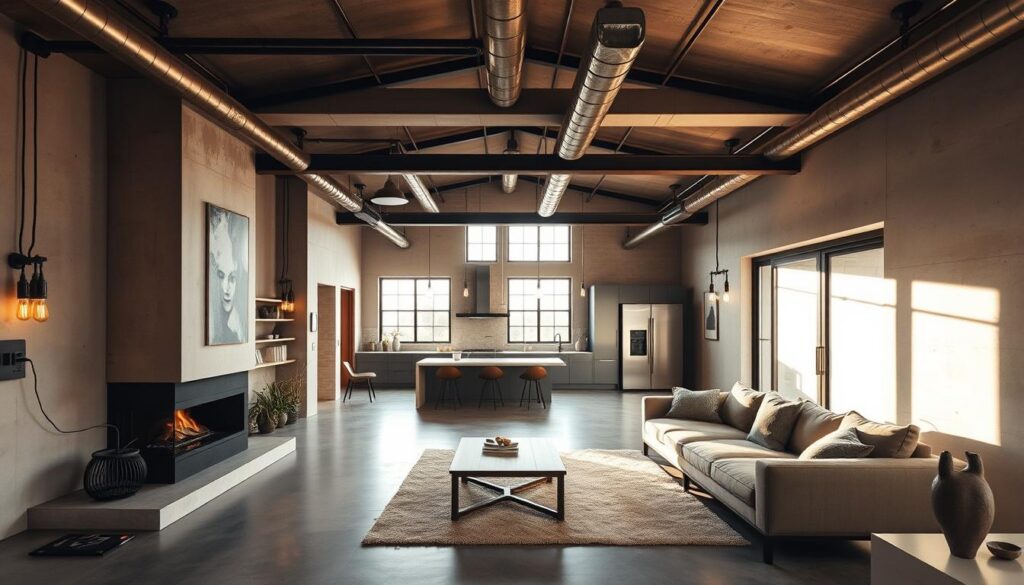
Best Materials for an Industrial Look
To get an industrial vibe, use concrete, steel, and reclaimed wood in your decor. These materials make your space look good and last long.
When adding industrial touches to your home, mix different textures and materials. For example, combining metal with wooden furniture makes a room more interesting.
Minimalist Home Styles
Exploring minimalist home styles, we find the beauty in simplicity. It’s about decluttering and creating a space that’s both functional and beautiful.
Decluttering for Minimalism
Decluttering is key to a minimalist home. It’s not just about getting rid of stuff. It’s about curating what we keep to make our space feel open and calm.
To declutter, start with one area at a time. Sort items into keep, donate, and discard piles. Be honest with yourself about each item’s purpose or joy.
Tips for Effective Decluttering:
- Start small, focusing on one area at a time.
- Sort items into keep, donate, and discard piles.
- Be intentional about what you keep.
Color Schemes for Minimalist Spaces
The color scheme is vital in minimalist design. The right colors can make a space feel calm and simple. Neutral colors like whites, grays, and beige are popular for their clean look. But, a subtle pop of color can add interest.
Popular Minimalist Color Schemes:
| Color Scheme | Description | Example Colors |
|---|---|---|
| Monochromatic | Using different shades of a single color to create a cohesive look. | Various shades of white and cream. |
| Neutral with a Pop of Color | Combining neutral tones with a bold accent color. | Grays with a bold red accent. |
| Soft Pastels | Using soft, pastel colors to create a soft and calming atmosphere. | Soft pink, baby blue, and mint green. |
Embracing minimalist home styles lets us create spaces that are beautiful and calming. Every choice we make, from decluttering to color schemes, shapes our home’s look and feel.
Eclectic Home Styles
The eclectic style mixes different elements to create a unique space. It lets us show our personal taste and style. This makes our home special and inviting.
Mixing Different Styles Effectively
To mix styles well, find a common thread. This could be color, texture, or era. This thread ties everything together.
For example, we can pair vintage furniture with modern decor. Choose pieces that share a common material or style. A vintage armchair and a modern sofa can work together if they match in color or pattern.
Key Considerations:
- Identify a unifying element among different pieces.
- Balance contrasting styles with harmony.
- Experiment with different textures and colors.
Tips for Creating an Eclectic Space
Creating an eclectic space needs careful planning. Here are some tips to help:
- Start with a neutral base: Use a neutral wall or floor as a calm background.
- Mix and match: Combine different styles, textures, and colors for interest.
- Add statement pieces: Use unique items to add personality.
As design experts say, “The key to a successful eclectic space is balance and cohesion.” Experiment with layouts until we find a harmonious arrangement.
“Eclecticism is about embracing the unexpected and making it work. It’s a celebration of individuality and personal style.”
| Style | Characteristics | Examples |
|---|---|---|
| Modern | Clean lines, minimal ornamentation | Modern art, sleek furniture |
| Vintage | Ornate details, classic patterns | Antique furniture, vintage decor |
| Eclectic | Mix of different styles, textures, and colors | Combining vintage and modern pieces |
By embracing eclectic home styles and following these tips, we can create a unique and captivating living space that reflects our personality and style.
Bohemian Home Styles
Bohemian home styles are perfect for those who love to show their unique side. They offer a space for creativity and self-expression. Bohemian interiors are known for their vibrant and eclectic mix, making each space truly unique.
Characteristics of Bohemian Design
Bohemian design is all about being free-spirited. It combines vintage and global elements in a unique way. This style brings together different cultures and times, creating a rich look.
- Use of vibrant colors and patterns
- Incorporation of vintage and antique pieces
- Mix of different textures and materials
- Global influences and cultural elements
To get a bohemian look, don’t be afraid to mix styles. You can pair modern furniture with vintage decor. Or, mix bold patterns with solid colors.
Incorporating Textiles in Bohemian Interiors
Textiles are key in bohemian interiors. They add depth, texture, and interest. From colorful rugs to vintage quilts, they make a space cozy and inviting.
Some favorite textiles for bohemian homes include:
| Textile | Description |
|---|---|
| Moroccan Rugs | Vibrant, colorful, and intricately patterned |
| Vintage Quilts | Unique, handmade, and rich in history |
| Indian Block Prints | Characterized by bold patterns and bright colors |
Using many textiles adds interest and coziness. It’s perfect for a bohemian home.
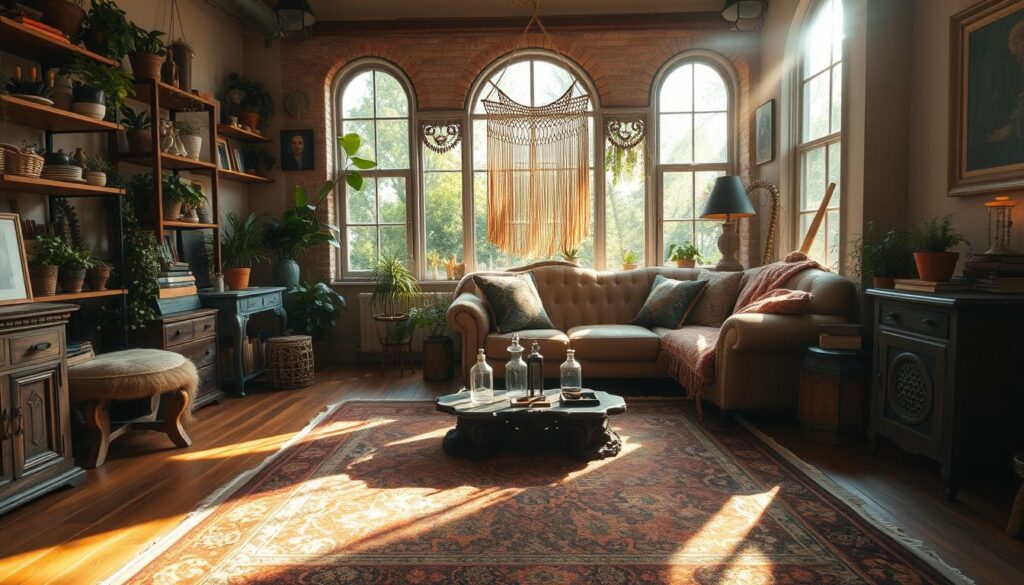
Embracing bohemian style lets you create a space that’s truly yours. It shows your individuality and creativity.
Coastal Home Styles
Coastal home styles bring a calm feel to our homes. They are great for those who love the beach. They help us feel the coast’s peace in our living spaces.
Elements of Coastal Decor
Coastal decor uses natural materials like driftwood, sea glass, and woven fibers. These create a relaxed feel. Nautical accents like anchors, ropes, and navy blues add a sea touch to your home.
Soft textures are key in coastal design. Think plush area rugs, throw blankets, and linen upholstery. Adding plants and shells makes the space feel organic.
Color Palettes Inspired by the Shore
The color palette is vital in coastal home styles. Blue, from sky tones to navy, brings the ocean’s feel. Whites and creams, like sea foam and sand, are also used. Earthy tones like sage green and sandy beige ground the space and connect us to nature.
| Color | Inspiration | Usage |
|---|---|---|
| Soft Blue | Clear sky on a sunny day | Walls, bedding |
| Navy Blue | Deep ocean waters | Accent pieces, nautical decor |
| White/Cream | Sea foam and sand | Furniture, trim |
| Sage Green | Coastal foliage | Plants, accent walls |
By using these elements and colors, we can make our homes coastal and stylish. It doesn’t matter if you’re by the beach or just dreaming. This style brings the coast’s calm into your home.
Craftsman Home Styles
The Craftsman style is loved for its handcrafted details and natural materials. It creates a warm and inviting home. This style comes from the Arts and Crafts movement, focusing on the beauty of handmade things and natural materials.
Understanding Craftsman Aesthetics
Craftsman style emphasizes handcrafted details, natural materials, and a cozy feel. It brings the outdoors inside, using wood, stone, and brick for warmth and comfort.
Some key elements of Craftsman style include:
- Exposed beams and rafters
- Handcrafted woodwork, such as built-in cabinetry and furniture
- Natural materials, like wood, stone, and brick
- Earth-toned color palettes
Stickley, a key figure in the Arts and Crafts movement, said, “The test of a work of art is not the amount of money it costs, but whether it is a sincere expression of the artist’s own individuality.” This quote captures the essence of Craftsman style, valuing authenticity and craftsmanship.
“The home should be the treasure chest of living.” –
Essential Details in Craftsman Homes
To incorporate Craftsman style in your home, consider these essential details:
| Detail | Description |
|---|---|
| Built-in Cabinetry | Handcrafted cabinetry built into walls, offering storage and showcasing craftsmanship. |
| Exposed Beams | Exposed beams and rafters that add warmth and coziness. |
| Natural Materials | Using natural materials like wood, stone, and brick for a warm atmosphere. |
Adding these elements can make your home look and feel like a Craftsman-inspired space. For modern home decor ideas, mix Craftsman elements with modern touches for a unique and welcoming home.
Choosing the Right Style for Our Space
Exploring interior home styles is exciting. From classic to contemporary, we need to pick one that shows who we are and fits our lifestyle. Mixing different styles can lead to a unique look that stands out.
Assessing Personal Preferences
Choosing the right style means looking at our lifestyle and what we like. Knowing our tastes helps us pick a style that feels like home. This way, our space will truly reflect us.
Harmonizing Styles
Combining styles needs a common thread, like a color or texture. This thread ties the space together. By blending trends with our taste, we get a space that looks good and works well.

